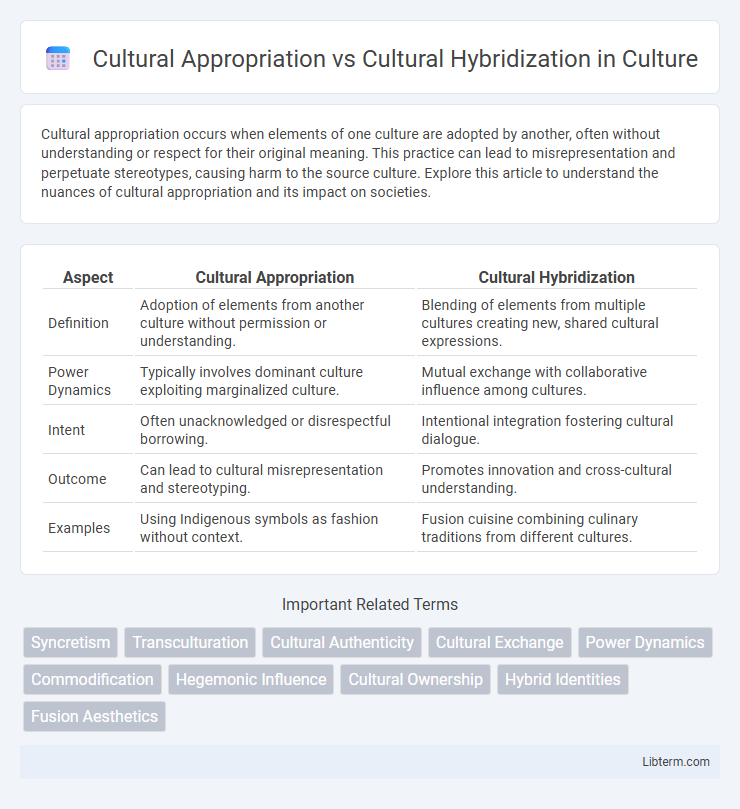Cultural appropriation occurs when elements of one culture are adopted by another, often without understanding or respect for their original meaning. This practice can lead to misrepresentation and perpetuate stereotypes, causing harm to the source culture. Explore this article to understand the nuances of cultural appropriation and its impact on societies.
Table of Comparison
| Aspect | Cultural Appropriation | Cultural Hybridization |
|---|---|---|
| Definition | Adoption of elements from another culture without permission or understanding. | Blending of elements from multiple cultures creating new, shared cultural expressions. |
| Power Dynamics | Typically involves dominant culture exploiting marginalized culture. | Mutual exchange with collaborative influence among cultures. |
| Intent | Often unacknowledged or disrespectful borrowing. | Intentional integration fostering cultural dialogue. |
| Outcome | Can lead to cultural misrepresentation and stereotyping. | Promotes innovation and cross-cultural understanding. |
| Examples | Using Indigenous symbols as fashion without context. | Fusion cuisine combining culinary traditions from different cultures. |
Understanding Cultural Appropriation: Definition and Examples
Cultural appropriation involves adopting elements of one culture by members of another, often without permission or understanding, leading to misrepresentation or disrespect. Common examples include using sacred symbols as fashion accessories or adopting traditional hairstyles devoid of their cultural significance. This practice contrasts with cultural hybridization, which fosters mutual exchange and blending of cultural traits in a respectful and co-creative manner.
Cultural Hybridization: What It Means in a Globalized World
Cultural hybridization refers to the dynamic process where distinct cultural elements blend to create new, innovative forms of expression in a globalized world. This phenomenon fosters cross-cultural exchanges that enrich societies by combining traditions, languages, and practices, leading to unique hybrid identities and innovations. Unlike cultural appropriation, which often involves power imbalances and exploitation, cultural hybridization emphasizes mutual influence, respect, and the evolution of culture through interconnectedness and collaboration.
Key Differences Between Appropriation and Hybridization
Cultural appropriation involves adopting elements of a marginalized culture by a dominant group without permission, often leading to misrepresentation or exploitation. Cultural hybridization refers to the blending of different cultural practices and symbols, resulting in new, shared meanings through mutual exchange and interaction. Key differences include power dynamics, intent, and respect for cultural origins, where appropriation often reinforces inequality, while hybridization fosters cultural dialogue and innovation.
Historical Roots of Cultural Exchange and Borrowing
Cultural appropriation and cultural hybridization both trace back to historical interactions where societies exchanged and borrowed elements such as language, art, and technology. While cultural appropriation often involves the adoption of cultural symbols without understanding or respect, cultural hybridization highlights the mutual blending and creation of new cultural forms through sustained contact. Key examples include the Silk Road's facilitation of diverse cultural exchanges and the Columbian Exchange's impact on agriculture and cuisine across continents.
Power Dynamics: Who Benefits from Cultural Appropriation?
Cultural appropriation often benefits dominant groups by allowing them to exploit marginalized cultures' symbols and practices for personal gain, commodification, or social capital without reciprocal respect or understanding. Power dynamics skew heavily in favor of those in dominant positions who control mainstream narratives, reinforcing systemic inequalities and cultural erasure. In contrast, cultural hybridization involves more equitable exchanges where cultures blend organically, fostering mutual respect and shared power in cultural innovation.
Case Studies: Fashion, Art, and Music Across Cultures
Cultural appropriation in fashion, art, and music often involves dominant cultures adopting elements from marginalized groups without understanding their significance, leading to misrepresentation and exploitation. Case studies reveal that Native American headdresses used superficially in fashion shows or pop music sampling indigenous sounds without credit exemplify appropriation controversies. Conversely, cultural hybridization manifests in collaborations like Afrobeat fusion in global pop or Japanese streetwear blending traditional motifs with modern styles, promoting mutual respect and creative exchange across cultures.
The Ethics of Cultural Sharing in Modern Society
Cultural appropriation involves the uncontrolled adoption of elements from one culture by another, often leading to disrespect and marginalization of the original community, whereas cultural hybridization fosters mutual exchange and innovation through respectful blending of cultural identities. Ethical cultural sharing in modern society demands awareness of power dynamics, consent, and recognition of cultural origins to avoid exploitation and promote equitable respect. Emphasizing cultural hybridity encourages diversity and creativity while ensuring that cultural practices are exchanged with sensitivity and integrity.
Navigating the Fine Line: Respectful Collaboration vs Exploitation
Cultural appropriation often involves the unacknowledged or exploitative use of elements from marginalized cultures, leading to harm and misrepresentation. In contrast, cultural hybridization emphasizes respectful collaboration where different cultural expressions merge, creating new meanings through mutual exchange and consent. Navigating this fine line requires sensitivity to power dynamics, authentic engagement, and acknowledgment of cultural origins to avoid exploitation and foster genuine intercultural dialogue.
Cultural Hybridization: Driving Innovation and Inclusivity
Cultural hybridization drives innovation and inclusivity by blending diverse cultural elements, fostering creative collaboration and new perspectives in art, technology, and social practices. This dynamic process enhances cultural exchange, allowing societies to evolve through shared experiences and mutual respect, contrasting with cultural appropriation, which often involves exploitation or misrepresentation. Emphasizing cultural hybridization promotes a more inclusive environment where diversity is celebrated and contributes to social cohesion and global interconnectedness.
Fostering Cross-Cultural Understanding in a Connected World
Cultural appropriation often involves the adoption of elements from one culture by another in a way that can exploit or disrespect the original culture, whereas cultural hybridization blends diverse cultural aspects to create new, shared practices that promote mutual respect and understanding. Fostering cross-cultural understanding in a connected world requires emphasizing cultural hybridization, which encourages collaboration, empathy, and the celebration of diversity. This approach supports global interconnectedness by transforming cultural exchange into a dynamic process that values all participants and their unique contributions.
Cultural Appropriation Infographic

 libterm.com
libterm.com